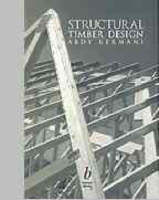
Structural Timberwork
Blackwell Science Ltd (Verlag)
978-0-632-05091-8 (ISBN)
- Titel ist leider vergriffen;
keine Neuauflage - Artikel merken
"Structural Timber Design" is a comprehensive textbook which provides HND and undergraduate students of building and civil engineering courses with a wealth of information and in-depth guidance on design methods to the recently revised BS 5268: Part 2 and the proposed Eurocode 5. It is also an invaluable reference source and design aid for practising engineers. The book provides a step-by-step approach to the design of all the most commonly used timber elements and connections, illustrated by detailed worked examples, and encourages the sue of computers to carry out design calculations. It covers the characteristics of timber; a review of BS 5268: Part 2 and its requirements; the design of beams and columns of solid, glued laminated and composite sections and of mechanical and glued timber connections. The book also reviews the proposed Eurocode 5 and its limit stated requirements, including the design of flexural and axially loaded members and connections.
Abdy Kermani is a Fellow of the Institute of Wood Science and lectures in structural analysis and design at Napier University, Edinburgh. He has been involved in and has led several research and development programmes on the structural use of timber and its reconstituted materials for over 15 years. His research work in timber engineering is widely recognised and published internationally.
Preface. 1. Timber as a structural Material. 1.1 Introduction. 1.2 The structure of timber. 1.3 Defects in timber. 1.4 types of timber. 1.5 Physical properties of timber. 1.6 References. 2. Introduction to BS 5268: Part 2: 1996. 2.1 Introduction. 2.2 Design philosophy. 2.3 Stress grading of timber. 2.4 Strength classes. 2.5 Design considerations (factors affecting timber strength). 2.6 Symbols. 2.7 References. 3. Using Mathcad for Design Calculations. 3.1 Introduction. 3.2 What is Mathcad? 3.3 What does Mathcad do? 3.4 Summary. 3.5 References. 4. Design of Flexural Members (Beams) 4.1 Introduction. 4.2 Design considerations. 4.3 Bending stress and prevention of lateral buckling. 4.4 Deflection. 4.5 Bearing stress. 4.6 Shear stress. 4.7 Suspended timber flooring. 4.8 References. 4.9 Design examples. 5. Design of Axially Loaded Members. 5.1 Introduction. 5.2 Design of compression members. 5.3 Design of tension members (Clause 2.12) 5.4 Design examples. 6. Design of Glued Laminated Members. 6.1 Introduction. 6.2 Design considerations. 6.3 Grade stresses for horizontally glued laminated members. 6.4 Grade stresses for vertically glued laminated beams. 6.5 Deformation criteria for glued laminated beams. 6.6 Curved glued laminated beams. 6.7 Bibliography. 6.8 Design examples. 7. Design of Ply-webbed Beams. 7.1 Introduction. 7.2 Transformed (effective) geometrical properties. 7.3 Plywood. 7.4 Design considerations. 7.5 References. 7.6 Design examples. 8. Design of Built-up (Spaced) Columns. 8.1 Introduction. 8.2 Spaced columns. 8.3 Design considerations. 8.4 Compression members in triangulated frameworks. 8.5 Reference. 8.6 Design examples. 9. Design of Timber Connections. 9.1 Introduction. 9.2 General design considerations. 9.3 Joint slip. 9.4 Effective cross-section. 9.5 Spacing rules. 9.6 Multiple shear lateral loads. 9.7 Nailed joints. 9.8 Screwed joints. 9.9 Bolted and dowelled joints. 9.10 Moment capacity of dowel-type fastener joints. 9.11 Connector joints. 9.12 Glued joints. 9.13 References. 9.14 Design examples. 10. Design to Eurocode 5. 10.1 Introduction. 10.2 Design philosophy. 10.3 Actions. 10.4 Material properties. 10.5 Ultimate limit sates. 10.6 Serviceability limit states. 10. 7 Reference. 10.8 Bibliography. 10.9 Design examples. Appendix A. Section sizes for Softwood Timber. Appendix B. Weights of Building Materials. Appendix C. Related British Standards for timber Engineering. Index.
| Erscheint lt. Verlag | 13.10.1998 |
|---|---|
| Verlagsort | Oxford |
| Sprache | englisch |
| Maße | 172 x 244 mm |
| Gewicht | 609 g |
| Themenwelt | Technik ► Bauwesen |
| Weitere Fachgebiete ► Handwerk | |
| ISBN-10 | 0-632-05091-8 / 0632050918 |
| ISBN-13 | 978-0-632-05091-8 / 9780632050918 |
| Zustand | Neuware |
| Haben Sie eine Frage zum Produkt? |
aus dem Bereich


